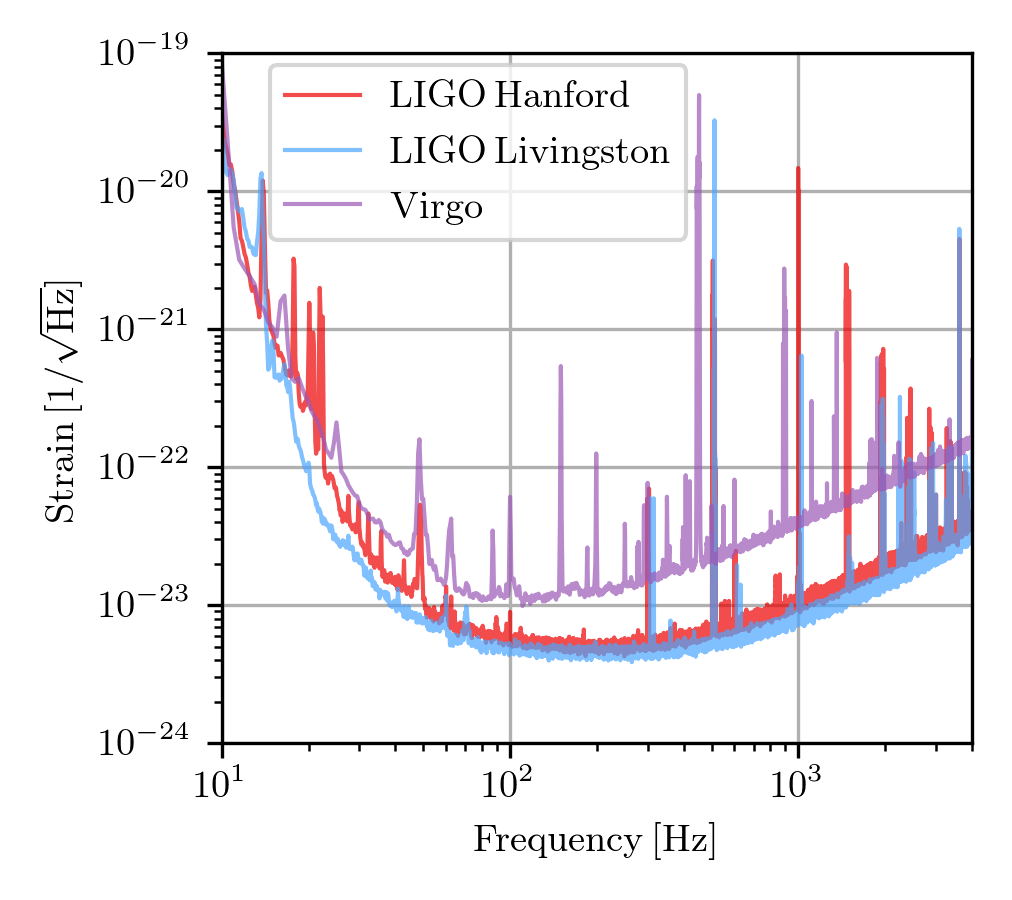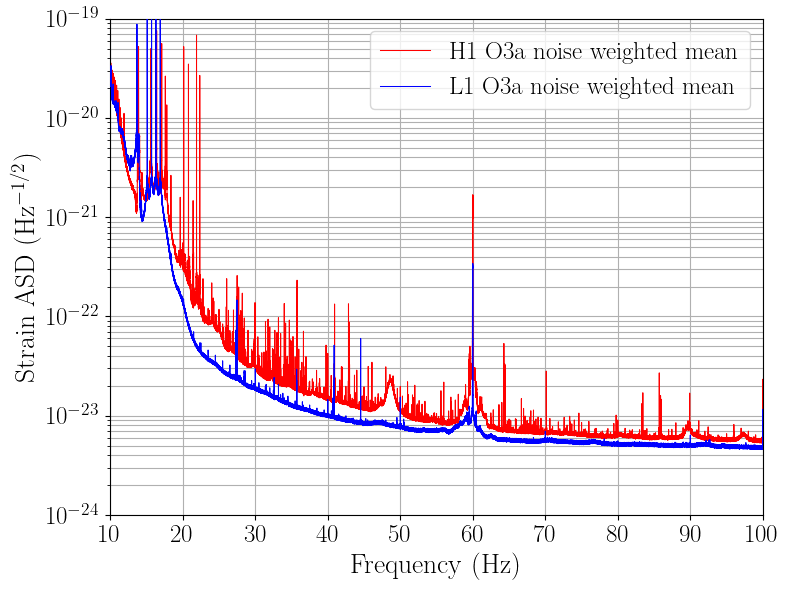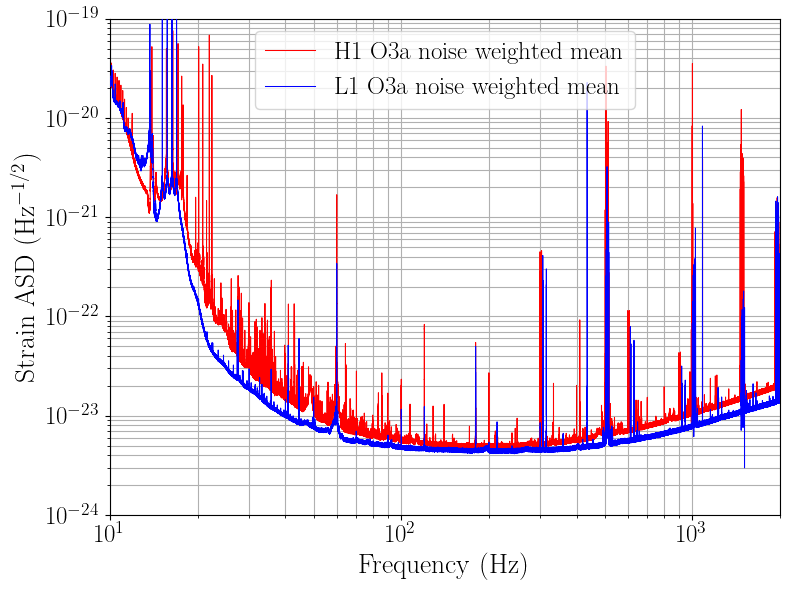O3 Instrumental Lines
The plot below shows the amplitude spectral density (ASD) of the total strain noise in the LIGO-Hanford(red line), LIGO-Livingston(blue line) and Virgo(violet line) detectors. The curves are representative of the best performance of each detector during O3a (from the O3a Catalog paper). The corresponding plot for O3b looks very similar. The plot shows frequency [Hz] on the x-axis, and the ASD value [ 1 / sqrt(Hz) ] on the y-axis. The data are not calibrated below 10 Hz and above 5 kHz.
The spectra reveal a large number of "lines" due to instrumental artifacts:

Impact on astrophysical searches
From Covas et. al. (2018):
"Searches are under way in Advanced LIGO and Virgo data for persistent gravitational waves from continuous sources, e.g. rapidly rotating galactic neutron stars, and stochastic sources, e.g. relic gravitational waves from the Big Bang or superposition of distant astrophysical events such as mergers of black holes or neutron stars. These searches can be degraded by the presence of narrow spectral artifacts (lines) due to instrumental or environmental disturbances."
Effort is put into understanding the instrumental origin of these lines, and engineering the detectors to keep the line bandwidth as narrow as possible. Line investigations are ongoing as we make hardware changes to mitigate and/or test coupling mechanisms of noise sources and strain data. Searches for persistent gravitational waves use various methods to remove known sources of contamination from the search results. Some details on the instrumental origin of these lines are given below and in the references.
The most prominent peaks
The peaks that are most noticeable to the eye are all believed to be due to known instrumental effects. For LIGO-Hanford and LIGO-Livingston we have:- 60 Hz power line harmonics around 60*n Hz, due to upconversion of low-frequency sesimic noise. These arise due to imperfect electromagnetic shielding, and magnetic coupling to the mirror suspensions.
- Thermally excited mirror suspension "violin modes" at ~500 Hz and and harmonics (1000, 1500, 2000 Hz). There is a "forest" of them due to the numerous mirror suspension fibers in the LIGO interferometers. These are an unfortunate but inevitable part of the LIGO detector design.
- Violin modes for the suspensions that hang the beam splitter around 300, 600, and 900 Hz.
- Calibration lines inserted by moving the end mirrors.
- Some lines due to evironmental disturbance were already identified in H1 both in O1 and O2 at frequencies of about 35.7 Hz
- 50 Hz electric mains and harmonics around 50*n Hz (first, second and third harmonic).
- Violin modes of the suspensions of the test masses (first mode at about 450 Hz and harmonics registered until the 5th order) and of the beam splitter (about 280 Hz).
- Calibration lines.
Other spectral features
In all detectors, there are "combs" of lines, evenly spaced and extremely
narrow, and typically in exact multiples of some fundamental frequency (like
1.0000 Hz). They are not visible in the plot above, but can be made visible in
very high resolution spectra with careful averaging over the entire run. The
two plots below show an example of high-resolution ASDs computed during O3a
for the LIGO-Hanford and LIGO-Livingston detectors. The corresponding plots
for O3b look similar. The plot on the left is a zoom-in at low frequencies (10
Hz - 100 Hz) while the one on the right shows the range 10 Hz - 2000 Hz:

 For
the LIGO detectors a complete description of lines and combs in O1 and O2 can
be found in this
paper
while the effort to identify and mitigate spectral artifacts in O3 is
discussed
here.
For
the LIGO detectors a complete description of lines and combs in O1 and O2 can
be found in this
paper
while the effort to identify and mitigate spectral artifacts in O3 is
discussed
here.
In addition to spectral artifacts with an identifiable instrumental origin, there are other artifacts whose origin remains unknown but their behavior is clearly non-astrophysical. The best example of this are the combs that are observed with an even spacing between each of the comb teeth. Other artifacts do not exhibit the expected Doppler modulation, expected amplitude modulation, or consistent amplitudes in different detectors. These are also clearly not astrophysical in origin and are considered an unknown artifact until a coupling mechanism is discovered.
At a few narrow frequency intervals, most notably around the violin suspension resonances of the main interferometer optics, there are observed downward excursions of the spectrum below the shot noise sensitivity of the detector. The origin of these “anti-line” features is not due to any cleaning procedure used in O3 and is clearly not physical, i.e., the detectors are not more sensitive in those narrow frequency bands. It is likely caused by miscalibrated data due to unmodelled parasitic coupling of auxiliary control loops and/or overdamping of violin resonances.
Those artifacts that have clear non-astrophysical origin are rejected by the CW searches conducted by the LIGO Scientific Collaboration and Virgo Collaboration.
References
- "Identification and mitigation of narrow spectral artifacts that degrade searches for persistent gravitational waves in the first two observing runs of Advanced LIGO" Phys. Rev. D 97 (2018) 082002;
- "LIGO Detector Characterization in the Second and Third Observing Runs" arXiv:2101.11673
- "All-sky search in early O3 LIGO data for continuous gravitational-wave signals from unknown neutron stars in binary systems" Phys. Rev. D 103 (2021) 064017
Instrumental line catalog
The following files contain lists of prominent spectral line frequencies. Each entry contains the line frequency, artifact type, estimated line width, and comments for each type of artifact. The intent is to identify spectral lines that we are confident are of instrumental (not astrophysical) origin, even if we don't understand the mechanism by which they show up in the strain data; they therefore are safe to ignore or "clean" (remove in an analysis-dependent way) when searching for CW signals.
- Text file line catalogs:
It is likely that you will need to speak with a LIGO or Virgo expert to understand the details of what you find in this catalog. You can start by checking our contact page.
